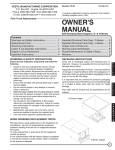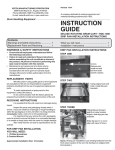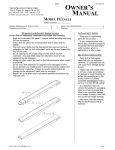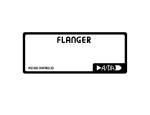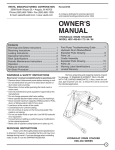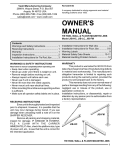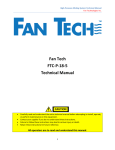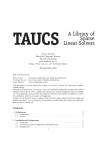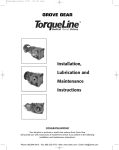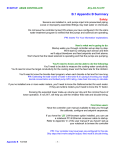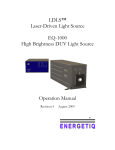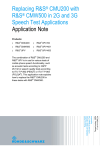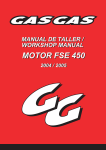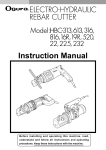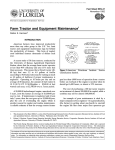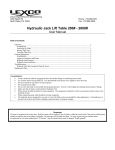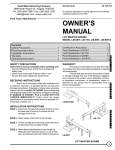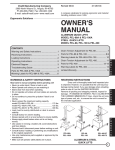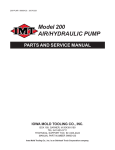Download owner`s manual
Transcript
VESTIL MANUFACTURING CORPORATION 2999 North Wayne St., P.O. Box 507 Angola, IN 46703 USA Phone (260) 665-7586 • Fax (260) 665-1339 www.vestil.com • [email protected] Revised 0307 21-126-103 A company dedicated to solving ergonomic and material handling problems since 1955. OWNER'S MANUAL HYDRAULIC POST TABLES Model HT-A Contents Warnings and Safety Instructions .................... 1 Receiving Instructions ..................................... 1 Warranty .......................................................... 1 WARNINGS & SAFETY INSTRUCTIONS Insure that all employees understand and follow the following instructions. • Read and understand the owner's manual before using or servicing the table. • Do not use the table if any damage or unusual noise is observed. • Always watch the table and any load on it carefully when it is being moved or used. • Avoid sudden stops or quick turns to prevent accidental tipping of the table. • Use caution if you slide a load onto the table top. • The table's load must be centered and evenly distributed on the table. • Do not perform any modifications to the table without the manufacturer's approval. Failure to receive authorization for changes to the equipment could void the warranty. • Maintenance and repairs are to be done only bypersonnel qualified to perform the required work. • Do not use brake fluid or jack oil in the hydraulic system. If oil is needed, use an anti-wear hydraulic oil with a viscosity grade of 150 SUS at 100°F, (ISO 32 @ 40° C), or a non-synthetic transmission fluid. • Use only replacement parts either supplied or approved by the manufacturer. RECEIVING INSTRUCTIONS Every unit is thoroughly tested and inspected prior to shipment. However, it is possible that the unit may incur damage during transit. If you see damage when unloading, make a note of it on the SHIPPER RECEIVER. Remove all packing and strapping material, inspect for damage. IF DAMAGE IS EVIDENT, FILE A CLAIM WITH Operating Instructions - HT-A .......................... 2 Routine Maintenance & Safety Checks ........... 2 2-Speed Foot Pump Parts/Drawing ..............3-4 THE CARRIER IMMEDIATELY! Also, check the platform size, type of power unit, etc., to see that the unit is correct for the intended application. WARRANTY This product is warranted for 90 DAYS from date of purchase to be free of manufacturing defects in material and workmanship. The manufacturer's obligation hereunder is limited to repairing such products during the warranty period, provided the product is sent prepaid back to the factory. This warranty does not cover normal wear of parts or damage resulting from any of the following: negligent use or misuse of the product, use or application contrary to installation instructions, or disassembly, repair or alteration by any person prior to authorization from a factory representative. 2-POST 4-POST SINGLE POST HYDRAULIC POST TABLES 1 OPERATION INSTRUCTIONS - HT-A LOADING: The load rating, in pounds, is shown on the capacity tag located on the base. It indicates the net capacity of the table, assuming a centered load. Permanent damage to the table or injury to personnel could result from exceeding the listed capacity. The load size should not exceed the table dimensions by more than 50% and should not exceed twenty-four inches in height. Do not use the base of the hydraulic table as a storage shelf. OPERATION: The manually-powered hydraulic tables are furnished with a foot-pump. On the single and two-post tables, step on the foot treadle to raise the table and step on the release lever on the right side of the pump to lower the table. The four-post table has a two-speed foot pump, separate from the lifting cylinder. Step on the foot treadle to raise the table. You can change the pump from the low-volume to high-volume by pulling the slide on top of the foot pump back toward the foot treadle. SAFETY: Keep all personnel clear of the machine when it is in operation. Do not exceed the table's load rating. Use caution to avoid tipping the table when placing or sliding a load onto or off of the table. Avoid obstacles that can cause the base to sudden stop when moving a loaded table, such as cracks in the floor or the corners of machines, etc. Doing so could cause the post table to tip over or allow the load to slide off the table. Never use the table if it is in need of repairs or if it seems to be malfunctioning. Notify your maintenance personnel if you notice anything out of the ordinary, such as odd noises, erratic motion, or damage to any part of the table or its components. ORDERING REPLACEMENT PARTS: We take pride in using quality parts on the equipment we manufacture. We are not responsible for equipment problems resulting from the use of unapproved replacement parts. To order replacement or spare parts for this equipment, contact the factory. In any communication with the factory, please be prepared to provide the machine's serial number, which is indicated on the machine dataplate. ROUTINE MAINTENANCE & SAFETY CHECKS - HT, LDLT Care should be taken to identify all potential hazards and comply with applicable safety procedures before beginning work. Only qualified individuals trained to understand mechanical devices and their associated electrical and hydraulic circuits should attempt troubleshooting and repair of this equipment. 2 (A) Before each use inspect the following, where applicable: 1.) Oil leaks. 2.) Pinched or chafed hoses. 3.) Damage or structural deformation to the structural members, the cylinder, the foot pump, etc. 4.) Unusual noise or binding or evidence thereof. (B) Inspect monthly for, where applicable: 1.) The oil level. Oil should be 1" to 1 1/2" below the cylinder's or the reservoir's fill hole with the lift in the fully lowered position. 2.) Oil leaks. 3.) Worn or damaged hydraulic hoses and electrical wires, if applicable. 4.) Integrity of the retaining rings and pins at all pivot points. 5.) Looseness, wear, or damage to the casters' bearings, mounting hardware, or surface material. 6.) Unusual noises. 7.) Information and warning labels being in place and in good condition. 8.) The need to clean off dirt and debris. (C) Yearly inspection The oil should be changed if the oil darkens, becomes gritty, or turns a milky color (indicating the presence of water). Replace with an anti-wear hydraulic oil with a viscosity grade of 150 SUS at 100°F, (ISO 32 @ 40°C). Ex: AW 32 or HO 150 hydraulic fluid, or non-synthetic transmission fluid. OPERATING INSTRUCTIONS FOR TWO- SPEED FOOT PUMP AIR BLEED PROCEDURE FOR TWO-SPEED FOOT PUMP FEATURES: Your new lift equipment has been supplied with an exclusive single-speed or two-speed foot pump. The internal features of your pump includes a primary pressure relief, pressure compensated return flow control valve, and an integrated lowering valve. Replacements are necessary. Whether your pump is a new installation, or has been recently serviced, air has likely entered the hydraulic system. The design of this pump includes an "air bleed screw" which will aid in the removal of unwanted air from the foot pump area of the hydraulic system. Use the following steps to remove this air from the system. OPERATING INSTRUCTIONS: Stay clear of moving parts. The platform will rise as the foot pedal is pumped. Depressing the release lever will lower the table at a controlled rate of descent. In the event the platform has been overloaded, the pressure relief will open because of excessive pressure buildup in the hydraulic system. Oil will bypass into the reservoir. Never increase the pressure relief setting more than necessary. Do not exceed the rated capacity of your equipment. 1) Check all fittings to be sure they are tight. Ensure that the oil is filled to within 1" of the top of the reservoir when the lift is in the fully lowered position. TWO-SPEED SELECTION: The two-speed hydraulic foot pump offers two "speeds". The low speed products low volume/high pressure. The high speed products high volume/low pressure. The operator has the option of selecting the optimum pump speed for the application at hand. Pump speeds are selected by sliding the "lock collar" (Item #2 on the parts identification) in or out. An occasional drop of oil will keep the collar working freely. 2) Locate the "air bleed screw" (item #34 on the pump body) and loosen approximately 1/2 turn counterclockwise. As soon as you have loosened the screw, slowly depress the foot pedal. This unit will force the air out of the pump chambers. Before you let the pump pedal return to the "up" or "home" position, tighten the air bleed screw. This will prevent air from reentering the pump chamber. Repeat the above procedure until the pump chamber is completely filled with oil and a "spongy" feel is no longer present. If the air bleeding procedure has been successful, the feel of the pump pedal will be firm and the complete stroke of the pump will produce fluid flow. Air can also become trapped in the hydraulic cylinder(s). Review your owners manual for air removal instructions. HYDRAULIC DIAGRAM FOR TWO-SPEED FOOT PUMP PRESSURE COMPENSATED FLOW CONTROL 2 SPEED FOOT PUMP PRESSURE CHECK VALVE 1GPM TO CYLINDER ADJ. PRESSURE RELIEF VALVE PRESSURE CHECK VALVE LOWERING VALVE 3 HYDRAULIC FOOT PUMP --- TROUBLE SHOOTING GUIDE TROUBLE SHOOTING (Read all instructions thoroughly prior to performing any maintenance.) SYMPTOMS • Foot pumping action does not raise platform. • Cylinder slowly drifts downward under load. • Cylinder pumps up, but will not go down. CYLINDER ROD BLEEDER SCREW REMEDY Tools required: 3 & 5 mm hex key wrenches Standard head screwdriver Adjustable wrench FLUID FILL FILL/ BREATHER PLUG PUMP PEDAL LINE 1) Adjust Release Pedal (Refer to figure below) • Loosen setscrew on release pedal. Rotate pedal counterclockwise until pedal touches the base. While holding pedal, use hex key wrench to turn release shaft counterclockwise to stop. (NOTE: Do not loosen lock nut on release pedal shaft.) Tighten pedal set screws. Release pedal. 2) Check Fluid Level • Remove fill/breather plug. • Fluid should be filled to 2-2 1/2 inches from bottom edge of hole when cylinder rod is in the lowered position. If overfilled, fluid may seep from fill/breather plug. (ISO #AW-32 ANTIWEAR HYDRAULIC PUMP OIL ONLY. FLUID MUST BE CLEAN! STRAIN FLUID IF NECESSARY). RELEASE VALVE ASSEMBLY CAP RELEASE PEDAL RELEASE PEDAL 3) Clean Release Valve Assembly • Remove release valve assembly cap and clean assembly (shown in exploded view.) • While assembly is removed, pump foot pedal vigorously at least five times. CAUTION: Fluid will discharge from release valve hole. This will dislodge any foreign matter from the ball socket. Clear hole of PRODUCT BASE debris and reassemble release valve and tighten cap. • Repeat procedure #2 to refill fluid. OVERLOAD BYPASS ADJUSTMENT SCREW 3 mm HEX KEY WRENCH PEDAL SET SCREW CCW MOTION RELEASE PEDAL ADJUSTMENT 4) Bleed Pump of Trapped Air • Pump up cylinder at least 4 inches. While putting pressure on the platform, release bleeder screw until fluid flows free and clear from behind the screw. Then tighten bleeder screw and release pressure from platform. Repeat procedure until no signs of air are present. If after following the above procedures the problem still exists or if unit is leaking fluid, please contact the factory at (260)665-7586. 4




